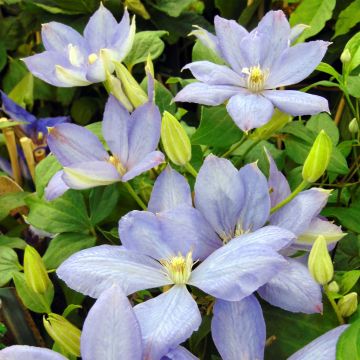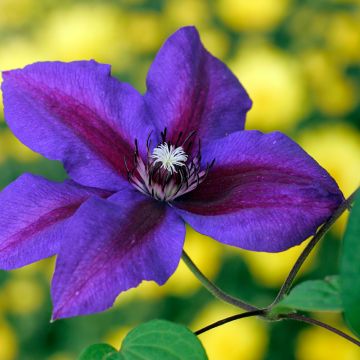

Clématite - Clematis Destiny
Clematis Destiny
Clematis Destiny
Old Man's Beard, Virgin's Bower, Traveller's Joy, Leather Flower
The buds haven't opened yet. But it has grown well.
Monique, , 25/05/2025
Special offer!
Receive a €20 voucher for any order over €90 (excluding delivery costs, credit notes, and plastic-free options)!
1- Add your favorite plants to your cart.
2- Once you have reached €90, confirm your order (you can even choose the delivery date!).
3- As soon as your order is shipped, you will receive an email containing your voucher code, valid for 3 months (90 days).
Your voucher is unique and can only be used once, for any order with a minimum value of €20, excluding delivery costs.
Can be combined with other current offers, non-divisible and non-refundable.
Home or relay delivery (depending on size and destination)
Schedule delivery date,
and select date in basket
This plant carries a 6 months recovery warranty
More information
We guarantee the quality of our plants for a full growing cycle, and will replace at our expense any plant that fails to recover under normal climatic and planting conditions.

Would this plant suit my garden?
Set up your Plantfit profile →
Description
The Clematis or Clematis 'Destiny' is a relatively recent variety, attractive with its refined flowering of white stars. It is an easy climbing perennial, equipped with voluble stems that wrap around supports on their own. This variety bears a generous and perpetual flowering in May-June and then in August-September with medium-sized flowers with beautifully undulated edges, all topped with a heart of stamens initially greenish and then turning white with purplish-brown anthers that enhance the purity of its petals. It is a very compact clematis, perfectly suited for growing in a pot on a terrace or in open ground in a small white garden! Use it to brighten up an unremarkable wall or as a backdrop for other more colourful clematis. Perfectly hardy, it is an easy perennial to grow if you take care to keep its base cool in a rich and well-drained substrate and its head in full light.
The genus Clematis belongs to the family of buttercups. The Clematis 'Destiny' is a German creation by William Straver in 2007.
It is a woody and climbing perennial plant, with short stems that will not exceed 1.5 m (5ft) in height with a spread of 1 m (3ft). The leaves, deciduous, fall in winter. They are bright green, composed of 3 ovate to lanceolate leaflets, 3 to 7 cm (1 to 3in) long and 1.5 to 5 cm (1 to 2in) wide, and traversed by relatively prominent veins. The single round-shaped flowers consist of 6 to 8 broadly elliptical to rounded sepals, overlapping and pointed at the tips. They are 7 to 10 cm (3 to 4in) wide. The flower is pure white with undulated edges. The stamens are greenish and then white with purplish-brown anthers. The colour of the flowers tends to fade at full bloom, especially when the plant is grown in very sunny conditions. This clematis clings to its support or host plant through voluble stems with petioles transformed into tendrils. This variety has good health and hardiness.
Plant your clematis in the company of your climbing roses or lianas to extend the flowering of your walls and pergolas until the end of summer. This is a diverse genus, with varieties available in all colours, shapes, and sizes. Take advantage of their easy cultivation to give your garden a romantic and bohemian touch. Thanks to its rather modest size, 'Destiny' will easily find its place in a small garden and will be perfectly happy in a pot on a balcony or next to an entrance door, embracing a small bamboo structure to welcome visitors with its magical colours. Its white flowers beautifully accompany more colourful blooms but are ideal in a predominantly white and green garden!
Report an error about the product description
Clematis Destiny in pictures




Plant habit
Flowering
Foliage
Botanical data
Clematis
Destiny
Ranunculaceae
Old Man's Beard, Virgin's Bower, Traveller's Joy, Leather Flower
Cultivar or hybrid
Other Clematis A to Z
View all →Planting and care
Choose a clear, well-sunlit exposure without being scorching, or in partial shade. In sunny exposure, shade the base of your plant with a ground cover or a perennial geranium. Clematises like to have their feet cool. Install your plant by covering the root ball with 3 cm (1in) of soil, in soil worked to a depth of 20 cm (8in), lightened with a good compost. During the first few weeks, water abundantly and regularly. Clematises cling on their own thanks to their tendrils. To promote their growth, provide them with a trellis support or let them dress the trunk of a tree by placing a mesh. Clematises also like to grow freely on neighboring plants. In early spring, prune the previous year's stems to about 15-20 cm (6-8in) from the ground, above a pair of large buds. We advise you not to water too much, as stagnant water can cause the development of a fungus deadly to plants at the base of your clematises.
Easy to grow in a large pot, filled with good horticultural soil.
Planting period
Intended location
Care
-
, onOrder confirmed
Reply from on Promesse de fleurs
Similar products
Haven't found what you were looking for?
Hardiness is the lowest winter temperature a plant can endure without suffering serious damage or even dying. However, hardiness is affected by location (a sheltered area, such as a patio), protection (winter cover) and soil type (hardiness is improved by well-drained soil).

Photo Sharing Terms & Conditions
In order to encourage gardeners to interact and share their experiences, Promesse de fleurs offers various media enabling content to be uploaded onto its Site - in particular via the ‘Photo sharing’ module.
The User agrees to refrain from:
- Posting any content that is illegal, prejudicial, insulting, racist, inciteful to hatred, revisionist, contrary to public decency, that infringes on privacy or on the privacy rights of third parties, in particular the publicity rights of persons and goods, intellectual property rights, or the right to privacy.
- Submitting content on behalf of a third party;
- Impersonate the identity of a third party and/or publish any personal information about a third party;
In general, the User undertakes to refrain from any unethical behaviour.
All Content (in particular text, comments, files, images, photos, videos, creative works, etc.), which may be subject to property or intellectual property rights, image or other private rights, shall remain the property of the User, subject to the limited rights granted by the terms of the licence granted by Promesse de fleurs as stated below. Users are at liberty to publish or not to publish such Content on the Site, notably via the ‘Photo Sharing’ facility, and accept that this Content shall be made public and freely accessible, notably on the Internet.
Users further acknowledge, undertake to have ,and guarantee that they hold all necessary rights and permissions to publish such material on the Site, in particular with regard to the legislation in force pertaining to any privacy, property, intellectual property, image, or contractual rights, or rights of any other nature. By publishing such Content on the Site, Users acknowledge accepting full liability as publishers of the Content within the meaning of the law, and grant Promesse de fleurs, free of charge, an inclusive, worldwide licence for the said Content for the entire duration of its publication, including all reproduction, representation, up/downloading, displaying, performing, transmission, and storage rights.
Users also grant permission for their name to be linked to the Content and accept that this link may not always be made available.
By engaging in posting material, Users consent to their Content becoming automatically accessible on the Internet, in particular on other sites and/or blogs and/or web pages of the Promesse de fleurs site, including in particular social pages and the Promesse de fleurs catalogue.
Users may secure the removal of entrusted content free of charge by issuing a simple request via our contact form.
The flowering period indicated on our website applies to countries and regions located in USDA zone 8 (France, the United Kingdom, Ireland, the Netherlands, etc.)
It will vary according to where you live:
- In zones 9 to 10 (Italy, Spain, Greece, etc.), flowering will occur about 2 to 4 weeks earlier.
- In zones 6 to 7 (Germany, Poland, Slovenia, and lower mountainous regions), flowering will be delayed by 2 to 3 weeks.
- In zone 5 (Central Europe, Scandinavia), blooming will be delayed by 3 to 5 weeks.
In temperate climates, pruning of spring-flowering shrubs (forsythia, spireas, etc.) should be done just after flowering.
Pruning of summer-flowering shrubs (Indian Lilac, Perovskia, etc.) can be done in winter or spring.
In cold regions as well as with frost-sensitive plants, avoid pruning too early when severe frosts may still occur.
The planting period indicated on our website applies to countries and regions located in USDA zone 8 (France, United Kingdom, Ireland, Netherlands).
It will vary according to where you live:
- In Mediterranean zones (Marseille, Madrid, Milan, etc.), autumn and winter are the best planting periods.
- In continental zones (Strasbourg, Munich, Vienna, etc.), delay planting by 2 to 3 weeks in spring and bring it forward by 2 to 4 weeks in autumn.
- In mountainous regions (the Alps, Pyrenees, Carpathians, etc.), it is best to plant in late spring (May-June) or late summer (August-September).
The harvesting period indicated on our website applies to countries and regions in USDA zone 8 (France, England, Ireland, the Netherlands).
In colder areas (Scandinavia, Poland, Austria...) fruit and vegetable harvests are likely to be delayed by 3-4 weeks.
In warmer areas (Italy, Spain, Greece, etc.), harvesting will probably take place earlier, depending on weather conditions.
The sowing periods indicated on our website apply to countries and regions within USDA Zone 8 (France, UK, Ireland, Netherlands).
In colder areas (Scandinavia, Poland, Austria...), delay any outdoor sowing by 3-4 weeks, or sow under glass.
In warmer climes (Italy, Spain, Greece, etc.), bring outdoor sowing forward by a few weeks.












































